Floris Geerts
Covered Forest: Fine-grained generalization analysis of graph neural networks
Dec 10, 2024Abstract:The expressive power of message-passing graph neural networks (MPNNs) is reasonably well understood, primarily through combinatorial techniques from graph isomorphism testing. However, MPNNs' generalization abilities -- making meaningful predictions beyond the training set -- remain less explored. Current generalization analyses often overlook graph structure, limit the focus to specific aggregation functions, and assume the impractical, hard-to-optimize $0$-$1$ loss function. Here, we extend recent advances in graph similarity theory to assess the influence of graph structure, aggregation, and loss functions on MPNNs' generalization abilities. Our empirical study supports our theoretical insights, improving our understanding of MPNNs' generalization properties.
Towards Bridging Generalization and Expressivity of Graph Neural Networks
Oct 14, 2024Abstract:Expressivity and generalization are two critical aspects of graph neural networks (GNNs). While significant progress has been made in studying the expressivity of GNNs, much less is known about their generalization capabilities, particularly when dealing with the inherent complexity of graph-structured data. In this work, we address the intricate relationship between expressivity and generalization in GNNs. Theoretical studies conjecture a trade-off between the two: highly expressive models risk overfitting, while those focused on generalization may sacrifice expressivity. However, empirical evidence often contradicts this assumption, with expressive GNNs frequently demonstrating strong generalization. We explore this contradiction by introducing a novel framework that connects GNN generalization to the variance in graph structures they can capture. This leads us to propose a $k$-variance margin-based generalization bound that characterizes the structural properties of graph embeddings in terms of their upper-bounded expressive power. Our analysis does not rely on specific GNN architectures, making it broadly applicable across GNN models. We further uncover a trade-off between intra-class concentration and inter-class separation, both of which are crucial for effective generalization. Through case studies and experiments on real-world datasets, we demonstrate that our theoretical findings align with empirical results, offering a deeper understanding of how expressivity can enhance GNN generalization.
A note on the VC dimension of 1-dimensional GNNs
Oct 10, 2024
Abstract:Graph Neural Networks (GNNs) have become an essential tool for analyzing graph-structured data, leveraging their ability to capture complex relational information. While the expressivity of GNNs, particularly their equivalence to the Weisfeiler-Leman (1-WL) isomorphism test, has been well-documented, understanding their generalization capabilities remains critical. This paper focuses on the generalization of GNNs by investigating their Vapnik-Chervonenkis (VC) dimension. We extend previous results to demonstrate that 1-dimensional GNNs with a single parameter have an infinite VC dimension for unbounded graphs. Furthermore, we show that this also holds for GNNs using analytic non-polynomial activation functions, including the 1-dimensional GNNs that were recently shown to be as expressive as the 1-WL test. These results suggest inherent limitations in the generalization ability of even the most simple GNNs, when viewed from the VC dimension perspective.
Weisfeiler-Leman at the margin: When more expressivity matters
Feb 12, 2024



Abstract:The Weisfeiler-Leman algorithm ($1$-WL) is a well-studied heuristic for the graph isomorphism problem. Recently, the algorithm has played a prominent role in understanding the expressive power of message-passing graph neural networks (MPNNs) and being effective as a graph kernel. Despite its success, $1$-WL faces challenges in distinguishing non-isomorphic graphs, leading to the development of more expressive MPNN and kernel architectures. However, the relationship between enhanced expressivity and improved generalization performance remains unclear. Here, we show that an architecture's expressivity offers limited insights into its generalization performance when viewed through graph isomorphism. Moreover, we focus on augmenting $1$-WL and MPNNs with subgraph information and employ classical margin theory to investigate the conditions under which an architecture's increased expressivity aligns with improved generalization performance. In addition, we show that gradient flow pushes the MPNN's weights toward the maximum margin solution. Further, we introduce variations of expressive $1$-WL-based kernel and MPNN architectures with provable generalization properties. Our empirical study confirms the validity of our theoretical findings.
A neuro-symbolic framework for answering conjunctive queries
Oct 06, 2023Abstract:The problem of answering logical queries over incomplete knowledge graphs is receiving significant attention in the machine learning community. Neuro-symbolic models are a promising recent approach, showing good performance and allowing for good interpretability properties. These models rely on trained architectures to execute atomic queries, combining them with modules that simulate the symbolic operators in queries. Unfortunately, most neuro-symbolic query processors are limited to the so-called tree-like logical queries that admit a bottom-up execution, where the leaves are constant values or anchors, and the root is the target variable. Tree-like queries, while expressive, fail short to express properties in knowledge graphs that are important in practice, such as the existence of multiple edges between entities or the presence of triangles. We propose a framework for answering arbitrary conjunctive queries over incomplete knowledge graphs. The main idea of our method is to approximate a cyclic query by an infinite family of tree-like queries, and then leverage existing models for the latter. Our approximations achieve strong guarantees: they are complete, i.e. there are no false negatives, and optimal, i.e. they provide the best possible approximation using tree-like queries. Our method requires the approximations to be tree-like queries where the leaves are anchors or existentially quantified variables. Hence, we also show how some of the existing neuro-symbolic models can handle these queries, which is of independent interest. Experiments show that our approximation strategy achieves competitive results, and that including queries with existentially quantified variables tends to improve the general performance of these models, both on tree-like queries and on our approximation strategy.
WL meet VC
Jan 26, 2023Abstract:Recently, many works studied the expressive power of graph neural networks (GNNs) by linking it to the $1$-dimensional Weisfeiler--Leman algorithm ($1\text{-}\mathsf{WL}$). Here, the $1\text{-}\mathsf{WL}$ is a well-studied heuristic for the graph isomorphism problem, which iteratively colors or partitions a graph's vertex set. While this connection has led to significant advances in understanding and enhancing GNNs' expressive power, it does not provide insights into their generalization performance, i.e., their ability to make meaningful predictions beyond the training set. In this paper, we study GNNs' generalization ability through the lens of Vapnik--Chervonenkis (VC) dimension theory in two settings, focusing on graph-level predictions. First, when no upper bound on the graphs' order is known, we show that the bitlength of GNNs' weights tightly bounds their VC dimension. Further, we derive an upper bound for GNNs' VC dimension using the number of colors produced by the $1\text{-}\mathsf{WL}$. Secondly, when an upper bound on the graphs' order is known, we show a tight connection between the number of graphs distinguishable by the $1\text{-}\mathsf{WL}$ and GNNs' VC dimension. Our empirical study confirms the validity of our theoretical findings.
Ordered Subgraph Aggregation Networks
Jun 28, 2022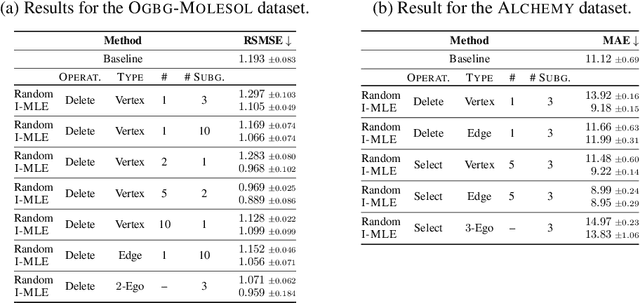
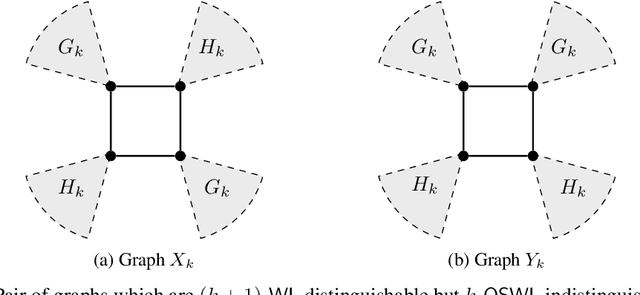
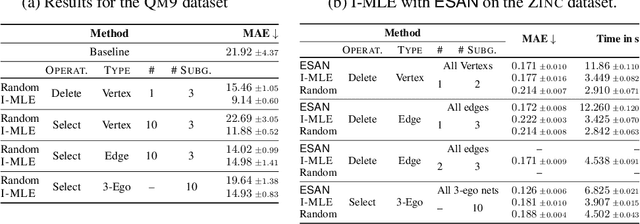

Abstract:Numerous subgraph-enhanced graph neural networks (GNNs) have emerged recently, provably boosting the expressive power of standard (message-passing) GNNs. However, there is a limited understanding of how these approaches relate to each other and to the Weisfeiler--Leman hierarchy. Moreover, current approaches either use all subgraphs of a given size, sample them uniformly at random, or use hand-crafted heuristics instead of learning to select subgraphs in a data-driven manner. Here, we offer a unified way to study such architectures by introducing a theoretical framework and extending the known expressivity results of subgraph-enhanced GNNs. Concretely, we show that increasing subgraph size always increases the expressive power and develop a better understanding of their limitations by relating them to the established $k\text{-}\mathsf{WL}$ hierarchy. In addition, we explore different approaches for learning to sample subgraphs using recent methods for backpropagating through complex discrete probability distributions. Empirically, we study the predictive performance of different subgraph-enhanced GNNs, showing that our data-driven architectures increase prediction accuracy on standard benchmark datasets compared to non-data-driven subgraph-enhanced graph neural networks while reducing computation time.
Expressiveness and Approximation Properties of Graph Neural Networks
Apr 10, 2022Abstract:Characterizing the separation power of graph neural networks (GNNs) provides an understanding of their limitations for graph learning tasks. Results regarding separation power are, however, usually geared at specific GNN architectures, and tools for understanding arbitrary GNN architectures are generally lacking. We provide an elegant way to easily obtain bounds on the separation power of GNNs in terms of the Weisfeiler-Leman (WL) tests, which have become the yardstick to measure the separation power of GNNs. The crux is to view GNNs as expressions in a procedural tensor language describing the computations in the layers of the GNNs. Then, by a simple analysis of the obtained expressions, in terms of the number of indexes and the nesting depth of summations, bounds on the separation power in terms of the WL-tests readily follow. We use tensor language to define Higher-Order Message-Passing Neural Networks (or k-MPNNs), a natural extension of MPNNs. Furthermore, the tensor language point of view allows for the derivation of universality results for classes of GNNs in a natural way. Our approach provides a toolbox with which GNN architecture designers can analyze the separation power of their GNNs, without needing to know the intricacies of the WL-tests. We also provide insights in what is needed to boost the separation power of GNNs.
On the expressive power of message-passing neural networks as global feature map transformers
Mar 17, 2022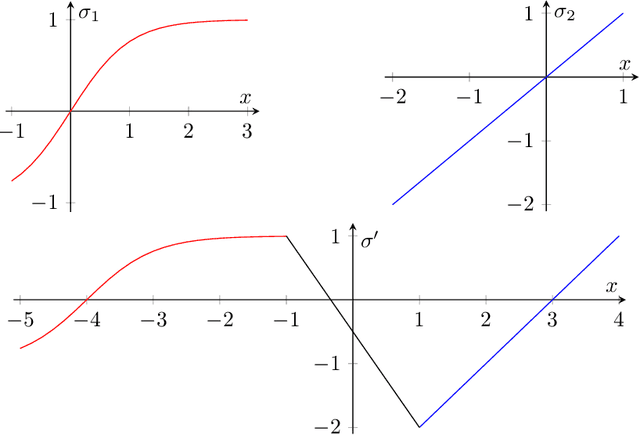
Abstract:We investigate the power of message-passing neural networks (MPNNs) in their capacity to transform the numerical features stored in the nodes of their input graphs. Our focus is on global expressive power, uniformly over all input graphs, or over graphs of bounded degree with features from a bounded domain. Accordingly, we introduce the notion of a global feature map transformer (GFMT). As a yardstick for expressiveness, we use a basic language for GFMTs, which we call MPLang. Every MPNN can be expressed in MPLang, and our results clarify to which extent the converse inclusion holds. We consider exact versus approximate expressiveness; the use of arbitrary activation functions; and the case where only the ReLU activation function is allowed.
Graph Neural Networks with Local Graph Parameters
Jun 12, 2021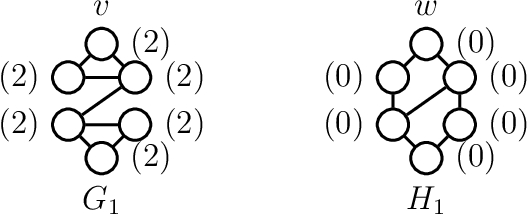

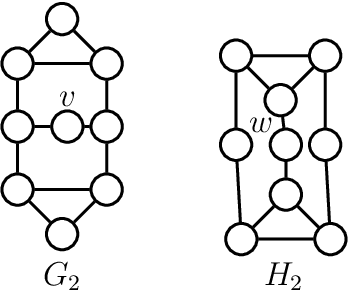
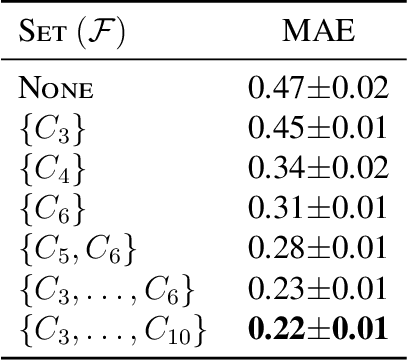
Abstract:Various recent proposals increase the distinguishing power of Graph Neural Networks GNNs by propagating features between $k$-tuples of vertices. The distinguishing power of these "higher-order'' GNNs is known to be bounded by the $k$-dimensional Weisfeiler-Leman (WL) test, yet their $\mathcal O(n^k)$ memory requirements limit their applicability. Other proposals infuse GNNs with local higher-order graph structural information from the start, hereby inheriting the desirable $\mathcal O(n)$ memory requirement from GNNs at the cost of a one-time, possibly non-linear, preprocessing step. We propose local graph parameter enabled GNNs as a framework for studying the latter kind of approaches and precisely characterize their distinguishing power, in terms of a variant of the WL test, and in terms of the graph structural properties that they can take into account. Local graph parameters can be added to any GNN architecture, and are cheap to compute. In terms of expressive power, our proposal lies in the middle of GNNs and their higher-order counterparts. Further, we propose several techniques to aide in choosing the right local graph parameters. Our results connect GNNs with deep results in finite model theory and finite variable logics. Our experimental evaluation shows that adding local graph parameters often has a positive effect for a variety of GNNs, datasets and graph learning tasks.
 Add to Chrome
Add to Chrome Add to Firefox
Add to Firefox Add to Edge
Add to Edge